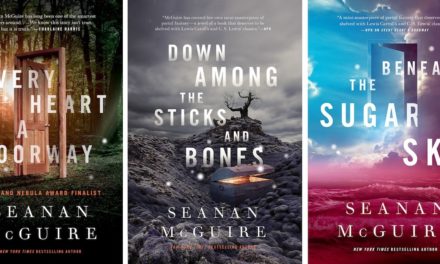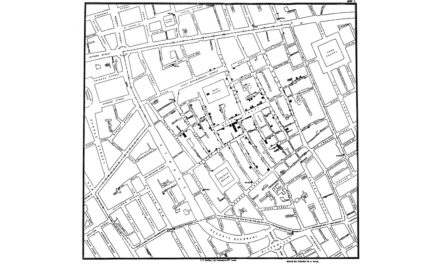Treating Rosacea: On Beautification, Nationalism, and Creative Resistance
by Rosa Boshier
Issue 1: GROTESQUE

“Roses” by Melanie Treuhaft, from set of Rosacea
All the flowery dreams I dreamed as a girl, stains that troubled…
–Yona Harvey, Hemming the Water
I overhear a docent at Huntington Gardens in San Marino, California waxing poetic on the myriad meanings of roses. “You’d think you were being handed a gift,” he said, “but really you were being marked for infidelity.” My creative collaborator and I have come to the gardens on a sweltering December day to capture footage of roses in all forms for the set of our upcoming theater piece, Rosacea. Although the play unpacks the British garden as signifier of order and violence, drawing a straight line between beautification and nationalism, at the Huntington we can’t help but forget the intentions of our visit and sink into enchantment. We glide through walls of cascading morning glories, rose petticoats over oak trees, and marble statues laced with camellias. Beauty is a relentless suitor.
The previous June, I was in the midst of a leisurely summer of study and artistic production. After finishing a residency in Barcelona, I headed to London to visit family. While in London, I thoroughly enjoyed the city—spending hours in museums and becoming a part-time resident of Hampstead Heath’s endless canopied paths. But as I prepared to leave, the Grenfell Tower fire occurred. Following the Manchester and London Bridge attacks, this became England’s third national tragedy in less than a year. The fire was decidedly different though—this violence was internal. Public safety had been jeopardized for the sake of beautification. Some of us watched on television while others returned home to their neighborhoods, smoldering reminders of national neglect. In the months to come, following the stories of Grenfell victims and observing the inadequacy of official response, I began to connect the dots. Rosacea emerged from exploring the relationship between nationalism, so-called “urban renewal” efforts, and the rigid aesthetics of landscape gardening.
It seems I would die if I drank
the extract of a rose—Liquid
petals, barely tamed fire
–Rose Lassi, Hemming the Water
With an annual attendance of 157,000 visitors, limited only by its three-acre capacity, The Royal Horticultural Society Chelsea Flower Show is the most prestigious garden show in Britain. Not five miles away in the same borough, more than 70 council housing residents died in the name of urban renewal. According to the Royal Horticultural Society, the flower show is meant to “reflect the celebratory mood of the country.” And it seems to do so, with shrubs trimmed and colored into orange and fuchsia giraffes—flower arrangements that dwarf human scale. The show celebrates class, luxury, and, of course, beauty in a borough in which the average residency price is £2 million but the median salary is a mere £32,700. In other words, it’s the ultimate pig in red lipstick. As The Economist points out, the wealth disparity in Chelsea and Kensington is not unlike what Dickens describes in A Tale of Two Cities. In the words of a local volunteer worker, “people live very close, but in different worlds.”
Ostensibly, the Grenfell tragedy resulted from a faulty appliance caught alight. When the blaze spread to outside of the tower, the cladding, foam boards coated in zinc that were recently fitted so as to better sell swanky Kensington and Chelsea high rises, caught fire and lit the building up like a Christmas tree. Within 20 minutes the entire building was ablaze. Residents had been told to stay in their homes and shut the doors, with the false reassurance that any fire within the tower could be contained within an hour. More than 70 people in the 27-story tower block lost their lives. Those lost were mostly low-income immigrants and people of color. A year earlier, when residents had protested the hazardous cladding, the Kensington and Chelsea Council threatened them with legal action.
Days after the fire, I began writing through unprocessed emotions. I had yet to think critically about what beauty and its vernacular protects. I grew up in an English and Colombian household, surrounded by the markers of “high culture”—white embroidery, pink satin, pearl earrings; my grandmother’s arroz con coco served on silver platters. Reflecting on these qualifiers of beauty, I began examining the purposes behind them. In many ways, these accessories are the packaging of a product less important than what it’s encased in. As Judith Hablerstam puts it in The Queer Art of Failure, we are often “speared by the seductions of the gift shop” rather than the treasures of the museum. I started to probe the social circumstances of the fire—what cultural and historical assumptions about value and aesthetics allowed for the tower’s exterior to be dubbed more important than the people inside it? The cladding shielded Kensington high-rise owners from the reality of socio-economic stratification, serving as shutters from the eyesore of council housing and from the increasing reality of poverty in developed countries. The Kensington and Chelsea Council chose to put residents’ lives at risk to uphold the varnish of perfection. The tactic was to mask inequity instead of reform it, but sooner or later the rotting ham thrown into the rosebush makes its presence known.
I now register the English garden and all the care and control it requires as a symbol of and vehicle for upholding nationalist ideals of white supremacy. What is behind the impulse to trim, sculpt, prune? Behind the need to control, to mask, and to master the wildness of nature? The fire seemed like a crude act of slash and burn—an eerie coincidence given increasing xenophobia in England, akin of that of the 1970s’ National Front movement. In response to the tragedy—legal jargon, empty apologies and promises. The deputy leader of Kensington and Chelsea Council, Kim Taylor-Smith, ran the media circuit with a montage of excuses, rhetoric that attempted to contain the state’s failings.
and she found herself in the—
… what? … who? … no! … she!
–Samuel Beckett, Not I
The intention of my writing after the fire was to find a creative form and strategy to address my untethered emotions. Theater seemed the only appropriate avenue from which to activate and unmask complacency and misguided patriotism and the hidden ways they manifest in our society. Equating beautification with nationalism, I began thinking of the British garden/gardening techniques as a metaphor for antiquated, often violent national ideals that lead to tragedies such as Grenfell, positioning the English rose—a symbol of British propriety—as a weapon. Rosacea became about showing the dystopia of the utopic vision of the Chelsea borough. Could the fire have been an excuse to rebuild “Paradise”? From this equivalency, the play’s character Adonis, a handsome man covered from head to toe in roses, was born. Adonis represents both the allure and evil of the nationalist ideal—how poisonous the rose can be.
••••
However, embedded in my formative approaches to creating work about the Grenfell Tower fire was the question of narrative ethics—what right did I have to write and why? I initially approached the play as an ode to the dead. I wrote what I presumed were the voices and lives of the victims. After presenting early drafts to friends and colleagues, I realized that this was a grave mistake. How does one address tragedy without re-traumatizing, fetishizing, or tokenizing those most affected? After expressing my concerns about writing on behalf of the dead, a mentor gave me invaluable guidance. He said, “Writing about the dead is like writing a love letter. How can you write a love letter if you don’t know your beloved?”
My answer came in a turn towards the absurd. Oversaturated by the pageantry of the news, I began thinking about the absurd as a creative tactic for resistance. How could I use repetition and the absurd to expose the culture of exceptionalism that detracted from lives lost? We live with the 24-hour news loop inside of us—a cycle of liked and shared material. What happens if one spotlights the loop? If, instead of being background screens at the dinner table or figures scrolled past on our phones, the loop became part of our aesthetic experience for the moment, naked and exposed for its own uselessness? Would we recognize our own complacency? When is witness violent?
In order to effectively respond to national horror I had to confront my role as a spectator of it. As both citizen and not, post-colonial subject and not, what could I contribute that might shed light on and lend insight around this event instead of fetishizing it? The British Broadcasting Corporation (BBC) rotated footage of a man who had lost his entire family in the fire as well as eyewitness accounts of a man who caught a baby flung by a desperate mother from the burning building. The steady swerve between heart-wrenching atrocity and squeaky-clean hope gave me whiplash. All the while, council members painted the fire as a freak accident, a one-off occurrence. The media brandished the tools of storytelling to dull and distract from affect instead of eliciting it. As an artist, I realized that the human drama in need of amplification was that of the dance of hiding the ham. I needed to put the half decomposed ham on stage and force audiences to smell it. But how could I move forward in a piece about accountability without exposing my own stench, the rot inside of me? Within the play, the Observers—three tourists of tragedy who text and tweet through their feelings—embody three modes of complacency that many of us participate in. We post on Facebook our grievances about police brutality, the prison industrial system, the sorry state of public education. We go to a protest once a year and emerge from the experience with nothing more than thousands of iPhone photos. Modeled after the Greek chorus who often mask their own faces, The Observers’ faces are already masks, frozen into melodramatic poses of “disgust” and “anguish.” The Greek chorus traditionally expresses what the main character of the play cannot express. Instead, The Observers signal and parody what we as a society cannot say or feel, rendering us immobile.
The ruined city will happen to follow me wherever I go…
–Reza Abdoh, Quotations from a Ruined City
“Because they let them burn for too long,” says a woman who lost her mother in the fire, when asked why the authorities cannot definitively confirm that her mother is dead. Her voice deadpans, she holds the interviewer in her gaze. I’ve often wondered what the woman and the interviewer shared in that moment. There’s a spark of recognition, of blinding exposure. She stares down into the ruined city behind the interviewer’s eyes. There is a stripping away, beyond the studio lighting, the goofy backdrop of a London bird’s-eye view. She refuses to sink into the sugar lining of excuses or decorate the incident with tears and finger pointing. She holds him accountable, and us, the spectators, accountable through him.
The ruined city will happen to follow me wherever I go. But can we invert it? Once we’ve located the ruined city within ourselves, how do we extract it? How can we mulch the rotting interior to grow something that blooms?

Rosa Boshier
Rosa Boshier is an MFA Creative Writing candidate at The California Institute of the Arts whose work spans multiple genres. Her writing has been published in The Rattling Wall, Entropy, and New Delta Review. She is a former Editorial Assistant at SUBLEVEL Magazine, and a current Editorial Fellow at Arts in a Changing America.




